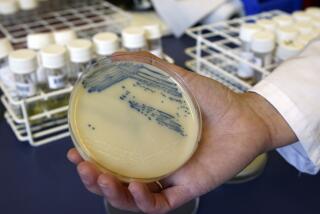New Discoveries May Aid Anthrax Battle
Scientists have made important new discoveries about the disease-causing properties of anthrax--insights that could help provide new and sorely needed therapies against the bacterium’s deadly toxins.
Such therapies, given with antibiotics, eventually could increase the survival rate of patients fighting rare yet deadly inhaled anthrax infections.
Anthrax bacteria in the body produce toxins that kill cells. Currently, by the time symptoms appear and a patient begins taking antibiotics, the level of poisons in the body can be so high that the patient dies even if the antibiotics kill the bacteria. There is no anthrax antitoxin currently available.
The new findings are from two separate research teams and are to be published in a Nov. 8 issue of the journal Nature. They were released weeks early in light of the recent spate of anthrax infections--including three fatalities--apparently from exposure to spores sent in the mail.
The findings are “extraordinary” and “spectacular,” said Dr. Anthony Fauci, director of the National Institute of Allergy and Infectious Diseases, who spoke Tuesday at a Washington news conference.
“It’s incumbent upon us to do as much as we can to translate [these findings] into something that would be for the public health,” he said.
One of the papers reports work by a team led by Robert Liddington at the Burnham Institute in La Jolla. The researchers have solved the detailed atomic structure of a protein called “lethal factor”--one of two proteins that together form the deadlier of anthrax’s two toxins.
“Clearly, if we could stop the action of this toxin, then we can save some lives,” Liddington said, speaking at the news conference with Fauci and other anthrax researchers.
Knowing the structure of the protein in such fine detail suggests ways that doctors could stop the toxin by blocking its effect on cells.
The other key discovery was made by scientists at the University of Wisconsin and Harvard Medical School. Scientists have long known that anthrax toxin gets into mammal cells by binding to a receptor on the cell surface, much as the HIV virus gets into human cells through binding to a receptor known as CD4. But the identity of the receptor to which anthrax toxin binds has been a mystery.
Now, after 2 1/2 years of intensive search, groups led by John Young at Wisconsin and John Collier at Harvard report that they’ve found the receptor. It, too, could be the target of new drugs.
The scientists have already tested one strategy in the lab. They designed a modified form of the receptor protein that floats around freely instead of being stuck in a cell’s membrane, then added the protein to mammalian cells in a dish, along with anthrax toxin.
The altered receptor protein stuck to all the toxin--mopping it up, in effect--and stopped it from killing cells.
More experiments are needed to determine whether a strategy built along those lines would work in people, but in theory, the modified protein could be used as an antitoxin that would be injected into a person after infection. But “so far, at least, we’ve only shown protection in cells that we grow on plastic dishes in the lab,” Young cautioned.
Such research efforts could well be key to future anthrax treatment, Fauci said. He likened the current anthrax research to the scientific work that led eventually to new AIDS therapies, such as protease inhibitors.
“I’m not saying that this is going to happen,” he said. “But I think there is a reasonably good chance” that the current research will “get us where we really need to be in this time of rather significant crisis for our nation.”




